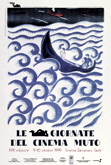
Le Giornate
del Cinema Muto
18th Pordenone
Silent Film Festival
Teatro Zancanaro, Sacile
9 - 16 October 1999
director: David Robinson
Sezioni
/Festival Features
What Made Her Do It?
NANI GA KANOJO O SO SASETA KA / [WHAT MADE HER DO IT? / COSA L’HA INDOTTA A FARE QUESTO?] (Teikine Studio, Japan, 1930)
Dir.: Shigeyoshi Suzuki; asst. dir.: Sotoji Kimura; cast: Keiko Takatsu; 35mm, 6.909ft. 92’(20fps), Koaru Yamakawa / Günter A. Buchwald. Didascalie in giapponese ricostruite / Reconstructed Japanese titles.
Nani ga Kanojo o so Saseta ka (Cosa l’ha indotta a fare questo?, 1930), ispirato a un successo del teatro Shingeki, è noto per essere una delle opere di punta del genere "film di tendenza" (keiko eiga).
Il film descrive l’opressione della società capitalista sulla sfortunata Sumiko che è "indotta a provocare un incendio doloso. La sua storia è raccontata attraverso flashbacks con angolazioni drammatiche, usate per il loro valore introspettivo. La ragazza nasceva povera e non riusciva a sfuggire alla miseria: era marchiata per tutta la vita. Quando questo film fu presentato nel quartiere Asakusa di Tokyo, il pubblico tumultuò appoggiando le tesi anticapitalistiche ed emozionandosi al punto da mettersi a urlare a gran voce ‘Abbasso il capitalismo’ e altre frasi analoghe. Fu il più grande successo del cinema giapponese muto, e venne replicato a Tokyo per parecchie settimane e a Osaka per due mesi. Dati gli immensi profitti ottenuti, nessuna casa potè fare a meno di produrre ‘film di tendenza’, indipendentemente dal loro contenuto politico. Nello stesso anno vennero infatti prodotti numerosi film di genere; fra gli altri Chosen (Sfida) e Ishin Anryu-shi (Una storia di correnti sotterranee durante la Restaurazione Meiji) di Eichi Koishi, l’ultimo dei quali si ispirava addirittura allo Scaramouche di Rafael Sabatini" (J.L. Anderson e D. Richie, Il cinema giapponese, Milano, Feltrinelli, 1961).
What Made Her Do It? (Nani ga Kanojo o so Saseta ka, 1930), which was based upon a popular Shingeki play is regarded as important as representing the "keiko eiga" or "tendency film". It portrays the oppression by a capitalist society of the unfortunate Sumiko, who is finally driven by desperation to commit arson.
"Her story is told in flashbacks with dramatic camera angles used for their introspective quality. She started life poor and there is no escape from her misery. She is branded for life. When this film was shown in Tokyo’s Asakusa district, audience rioted in support of its anti-capitalist sentiments, being excited to the point of loud cries of ‘Down with Capitalism!’ and the like. It became the biggest hit in the history of the silent Japanese cinema, running for many weeks in Tokyo and two months in Osaka. After the tremendous profits brought in by this film, no company could resist the tendency picture despite its political orientation. In the same year there was a spate of such pictures, among them Eichi Koishi’s Challenge (Chosen) and A History of Undercurrents during the Meiji Restoration (Ishin Anryu-shi), the latter with a plot taken from, of all things, Rafael Sabatini’s Scaramouche" (J. Anderson and D. Richie, The Japanese Film: Art and Industry, Tokyo, 1959).